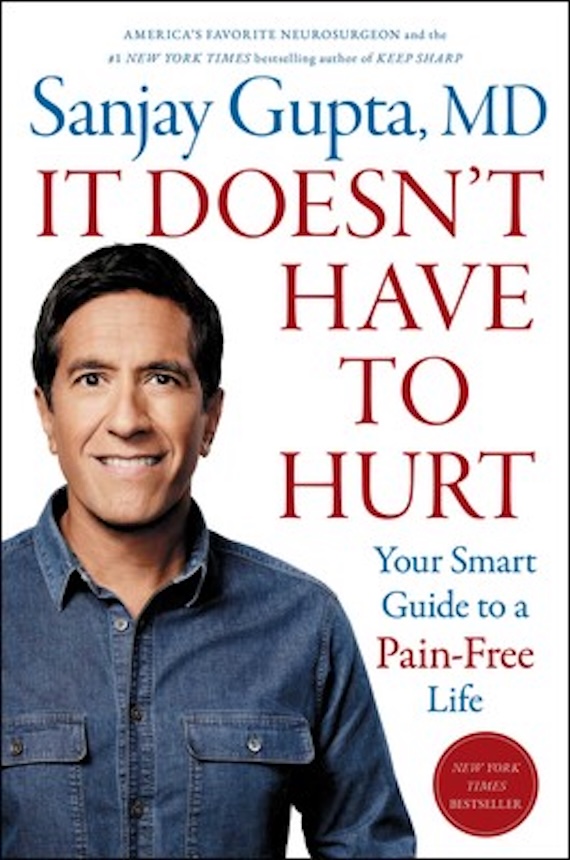BY Richard Penaskovic | –
Review of Sanjay Gupta, It Doesn’t Have to Hurt:Your Smart Guide to a Pain-free Life. (New York: Simon & Schuster, 2025), $30.00.
Dr. Sanjay Gupta, associate professor of neurosurgery at The Emory Hospital of Medicine, is the best-selling author of four books. He explains that in the past ten years experts like Richard Harris, a medical researcher at the University of California, at Irvine, have been studying the central neurobiological components of pain. Gupta points out that “there is hope, help, and healing” beyond anything we may have imagined, about pain.
Neurologists like Gupta tell us that the brain can grow, learn, and change in response to experience. It’s one of the brain’s superpowers to teach old neurons new tricks and grow new brain cells at any age. The “father of neuroplasticity,” Dr. Michael Merzenich, notes that the brain is soft-wired and is open to change when pain happens without an injury condition, such as fibromyalgia, chronic low back pain, or mixed-pain conditions. In short, the role of neuroplasticity becomes paramount.
The brain builds intricate circuits of knowledge and memory as one takes in new information. This is how we learn and retain what we learn, such as master skills like playing a musical instrument or how to read and write. Memory problems help one pay attention. Short-term memories go away quickly; however, long-term memories can be remembered for one’s entire lifetime.
Both chronic anxiety and depression have a strong connection to chronic pain. If one has chronic pain, one is likely to have five times more symptoms such as depression and chronic anxiety. Treatment failures add to the emotional burden of those suffering pain. Illness, loss, divorce, and other changes can shape one’s life in ways that make them more susceptible to pain. Risk factors for chronic pain are: chronic stress, inflammation, sedentary lifestyle and obesity, depression, anxiety, mental health challenges, other chronic diseases, social isolation and loneliness, social economic inequities that undermine healthcare and longevity.
We can do some basic things to reduce risk factors for pain: maintain a healthy diet and weight, do regular exercise, avoid alcohol and smoking, work and rest in a variety of healthy postures, and manage stress whenever needed. There’s no cure for chronic pain, but there are ways to cope. If one is in pain, one can still be happy. There’s always something that one can do to have a better quality of life. If physical therapy didn’t help much the first time, perhaps this time it may work. Hurt does not mean harm. Although a person cannot do all the things they used to do, this does not mean they cannot do anything. 7) Doing those things they can is important for individuals to enjoy the life they want to live.
The author suggests that lifestyle changes can improve the quality of life. Exercise, sleep, diet, and stress management can enhance the effectiveness of pain medication, thus reducing the amount one needs. The body has a strong capacity to heal itself. Given that individuals are producers as well as products of their life circumstances they are partial authors of their past conditions that developed them, as well as the future courses their lives take. The notion that we are the producers as well as the products of our own lives is a strong reminder that we have a great deal of control over our pain, and there are new strategies emerging to do just that.
Diet, sleep, exercise, and stress management together all act on pain in several ways. They increase cell-to-cell communication, lower inflammation, and set in motion psychological, neurological, and physiological processes that can reduce pain. Dr. Kathleen Sluka, a leading researcher in pain control argues that exercise works deeply across pain pathways, mechanisms, and systems that it changes one’s underlying causes of pain itself. In fact, exercise is the most effective multimodal treatment there is.
Gupta came up with Seven Reset Strategies that dovetail with each other. 1) Mindfulness means being present in the moment. Mindfulness can reduce anxiety, depression, and pain. Simply walking in nature may help one manage stress, calm pondering or thinking, and regulate emotion. Spending time outside improves mental well-being. 2) Be a friend of your body by using mind-body practices, such as acupuncture. 3) Do more exercise each day, as much as one can. 4) Develop habits that improve sleep. 5) Eat well and take dietary considerations as needed. 6) Support a sense of connection dealing with personal, social, and community relationships. 7) Enjoy memories, moments and positive experiences.
Gupta tells you to engage with “self-talk” or an inner dialogue with yourself. Be kind to yourself because you are the person you talk the most in your life. Use these qualities: emphasize your strengths, show self-compassion, tap into times you faced adversity, give yourself permission to take a break and take good care of yourself. Engage in self-encouragement such as: 1) I may not like my pain, but I can cope with it. 2) I am strong enough to handle what’s happening to me right now. 3) I have an opportunity to cope with my pain better. 4) I survived other situations with my pain and I’ll survive this one also. 5) My pain/fear/sadness/anxiety won’t kill me. It just doesn’t feel good now. 6) My thoughts don’t control my life, I do. 7) I am much more than my pain condition, that is, my life has meaning.
Gupta’s book is profound and well written. It is a must-read.



 © 2025 All Rights Reserved
© 2025 All Rights Reserved